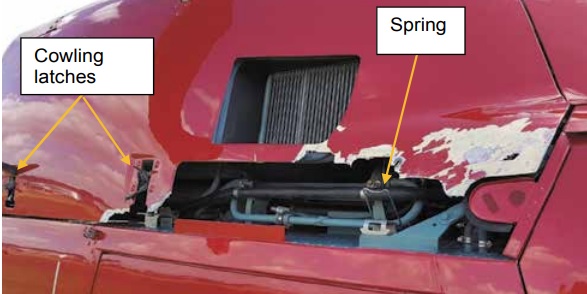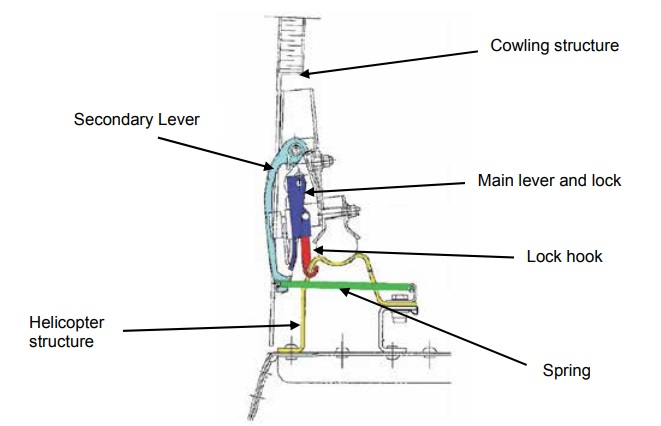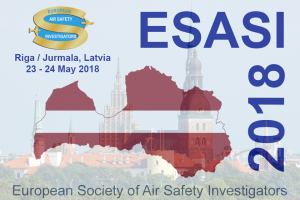EC120 Forgotten Walkaround
Maintenance, which included a compressor wash and an ‘A’ check, had been conducted on privately owned Airbus Helicopters EC120B G-SWNG. After the maintenance, according to the UK Air Accidents Investigation Branch (AAIB) report “the pilot left the helicopter for a short period of time” on 17 August 2017.
The pilot stated that when he returned to the helicopter, contrary to his normal practice, he forgot to complete a walkaround inspection of the helicopter before commencing the flight.
On approach to Wellesbourne, Warwickshire, an unusual noise was heard, and the pilot landed immediately.
Examination of the helicopter showed that the lower forward edge of the right engine cowling was damaged, the forward cowl latch assembly was missing and the centre latch had been damaged.
Damage was also observed on the inboard sections of all the main rotor blades.
The main rotor blade damage was caused by contact with the right engine cowling. The AAIB explain that the engine cowls hinge upwards and are held closed by 3 latches:
Closing the main lever of each latch places the latch hook under tension, securing the cowling to the structure and locks the main lever in the closed position.
The secondary lever will not close if the main lever is not in the locked position, providing a positive indication of an unlocked latch. When the secondary lever is closed a spring can then be moved over the tip of the secondary lever to prevent it from opening.
Inspection of the remaining two cowling latches confirmed that there was no evidence of unusual wear or damage to the latch hooks or the parts of helicopter structure where the hooks engage. There was no evidence of distortion or adverse wear to any of the springs used to retain the secondary latch levers.
The manufacturer issued Safety Information Notice No 2339-S-53 in June 2016 after previous in-flight cowl opening events:
This highlighted the need to inspect the condition and function of the cowl latches during the Daily Inspection.
In addition, the notice also advised that, for helicopters with a predominantly red colour scheme, the inside faces of the lock levers should be painted in a contrasting colour to the helicopter’s colour scheme, to provide an increased visual cue of an unlocked cowl latch. The inner faces of G-SWNG’s engine cowling lock levers had been painted in this manner.
AAIB Conclusions
In view of the maintenance activity immediately before the flight it is reasonable to conclude that the right engine cowling latches had not been correctly locked when the ‘A’ check was completed. Given that the inner faces of the latches had been painted in a contrasting colour to the helicopters paint scheme it is probable that this condition would have been observed by the pilot during a pre-flight walkaround inspection. The fact that the pilot left the helicopter for a short period of time before takeoff, coupled with the recent completion of routine maintenance, probably introduced sufficient interruption and distraction to the pilot’s normal pre-flight routine to cause him to forget to carry out a pre-flight walkaround inspection.
Other Safety Resources
In a recent article Flawed Post-Flight and Pre-Flight Inspections Miss Propeller Damage we noted that the Australian Transport Safety Bureau (ATSB) highlighted Flight Safety Foundation (FSF) guidance that after interruptions/distractions have been recognised and identified, the next priority is to re-establish situation awareness as follows:
- Identify: What was I doing?
- Ask: Where was I distracted?
- Decide/act: What decision or action shall I take to get ‘back on track’?
Acknowledging that some distractions cannot be avoided, but others can be minimised or eliminated is the first step in developing preventative strategies and lines-of-defence.
See also:
An excellent initiative to create more Human Centred Design by use of a Human Hazard Analysis is described in Designing out human error
HeliOffshore, the global safety-focused organisation for the offshore helicopter industry, is exploring a fresh approach to reducing safety risk from aircraft maintenance. Recent trials with Airbus Helicopters and HeliOne show that this new direction has promise. The approach is based on an analysis of the aircraft design to identify where ‘error proofing’ features or other mitigations are most needed to support the maintenance engineer during critical maintenance tasks.
The trial identified the opportunity for some process improvements, and discussions facilitated by HeliOffshore are planned for early 2018.
We have previously discussed other cowling and panel loss events:
- Human Factors of Dash 8 Panel Loss
- BA A319 Double Cowling Loss and Fire – AAIB Report
- BA A319 Double Cowling Loss and Fire – AAIB Safety Recommendation Update
- ANSV Report on EasyJet A320 Fan Cowl Door Loss: Maintenance Human Factors
- Tiger A320 Fan Cowl Door Loss & Human Factors: Singapore TSIB Report
- United Airlines Suffers from ED (Error Dysfunction)
- Time Pressures and Take-Off Trim Trouble
- When Habits Kill – Canadian Hughes 500 Helicopter Accident
- Flawed Post-Flight and Pre-Flight Inspections Miss Propeller Damage
- UPDATE 10 June 2019: Troublesome Tiedowns: The Sequel A Robinson R22 suddenly fails to respond to control inputs and descends and impacts the sea. Investigators find a tie-down wrapped around the main rotor head.
- UPDATE 25 April 2020: Fatal R44 Loss of Control Accident: Overweight and Out of Balance
- UPDATE 19 December 2020: Helicopter Destroyed in Hover Taxi Accident
- UPDATE 25 March 2023: Managing Interruptions: HEMS Call-Out During Engine Rinse
UPDATE 14 June 2018: AAIB briefly discuss another occurrence: AAIB investigation to AW109SP Grand New, G-IWFC: Incorrectly latched engine cowl, Sywell Aerodrome, Northamptonshire, 27 November 2017
UPDATE 1 July 2020: The National Transportation Safety Board (NTSB) discuss a Leonardo AW119 MkII Kola accident:
The pilot and the flight test engineer were completing a production test flight of the helicopter. A review of a surveillance video showed that, as they were preparing to land, the lower section of the left side of the engine cowling folded back and struck all four main rotor blades, which resulted in substantial damage to the blades. According to the operator/manufacturer, postaccident examination of the helicopter revealed that none of the fasteners on the left side of the cowling remained attached and that three of the fasteners were missing. No evidence of any preaccident discrepancies with the fasteners, the cowling, or the design and conformity of the helicopter structure was found.
According to the manufacturer/operator, before the flight, the pilot reported to maintenance personnel that he had seen that the fasteners attaching the generator duct to the right side of the same cowling appeared long. Maintenance personnel then removed the one-piece engine cowling, and a mechanic then replaced the generator duct fasteners and reinstalled the cowling with the help of another mechanic. The mechanic said he specifically fastened each of the fasteners on the cowling himself and checked all the fasteners after the cowling was reinstalled. Once the cowling was reinstalled, a quality inspector visually inspected the engine cowling fasteners. He did not see any anomalies and signed off that the work had been completed. The flight test engineer performed another preflight inspection of the helicopter and did not note any issues with any of the cowling fasteners. It is likely that the mechanic did not properly install the cowling fasteners before the flight, which resulted in the cowling coming loose and striking the main rotor blades.
The NTSB determined the probable cause of this accident to be:
The in-flight failure of the lower left side of the engine cowling due to the mechanic’s improper installation of the fasteners, which resulted in the cowling impacting all four main rotor blades.
The specific maintenance error is however not identified.
Aerossurance is pleased to sponsor the 9th European Society of Air Safety Investigators (ESASI) Regional Seminar in Riga, Latvia 23 and 24 May 2018.




Recent Comments